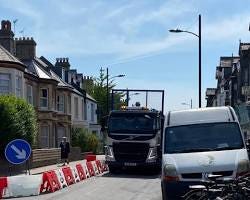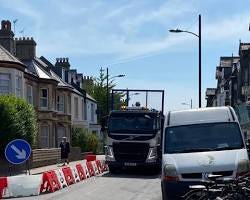East Bristol Liveable Neighbourhood: A Crushing Blow to the Most Vulnerable?
Residents voice outrage as controversial scheme exacerbates existing inequalities.
The implementation of the East Bristol Liveable Neighbourhood scheme continues to ignite fierce debate and, increasingly, anger amongst local residents. While Bristol City Council champions the initiative as a step towards a greener, safer community, a growing chorus of voices argues that the reality on the ground is far more damaging, particularly for the area's most disadvantaged populations. Critics contend that the scheme, far from fostering inclusivity, is actively undermining the quality of life for those already facing significant challenges, raising serious questions about the council's commitment to its own equality and anti-discrimination policies.
One particularly contentious aspect was the manner in which the initial road closures were implemented. Residents in Barton Hill awoke to find key routes blocked by planters and barriers, installed in the early hours of the morning. This tactic has been met with widespread condemnation, with many viewing it as a deliberate attempt to bypass community consultation and present residents with a fait accompli.
"This is a poorly-designed layout that is being steamrolled through by the Green Party," states a frustrated resident identifying as Freewheeler. "Once again, this Party does not listen to the most poverty-stricken or disadvantaged in the area. It is us who will receive the burden of this fiasco's failings, no thought has been given to the knock on effects. Surrounding roads are increasingly more heavily congested. The most obvious one of all is the already gridlocked Church Road. The entire scheme is a farce. If the Council knew what they were doing a reliable bus service would have been the first thing installed at the very least. The message is clear. Stay at home and don't harbour dreams of freedom of movement.”
Concerns are mounting that the increased congestion on boundary roads is disproportionately impacting vulnerable individuals. Those with mobility issues, for whom short, direct routes are essential, now face longer and more arduous journeys. Access to essential services, such as healthcare appointments, food banks, and community support centres, is becoming more difficult and time-consuming. For low-income families reliant on public transport or walking, the added inconvenience and potential cost of navigating the altered road network can be a significant burden.
The economic consequences are also a major worry. Local businesses, many of which serve the most disadvantaged communities, fear a decline in trade due to reduced accessibility for customers and deliveries. This could lead to job losses and further economic hardship in an area already grappling with poverty.
"It will also massively increase pollution as cars and lorries are left with idling engines for ages. How GREEN is that?!" argues a resident known as No Nonsense Yorkshire. This point highlights another potential negative impact on vulnerable residents, who often live in areas with higher levels of air pollution and are more susceptible to respiratory illnesses. The increased congestion caused by the scheme could exacerbate these existing health inequalities.
The feeling of being ignored and disenfranchised runs deep within the community. "The Green Party are just forcing this through, they do not care what anybody thinks or says or the effect it has, they are just carrying out their own personal agendas," adds Bboy, echoing the sentiment of many who feel their voices have been disregarded throughout the process.
This sense of being overlooked directly contradicts Bristol City Council's stated commitment to inclusivity and its anti-discrimination policy. The council's constitution emphasises "transparency" and "opportunities for public input," yet the early-morning implementation of road closures and the persistent claims of ignored feedback suggest a stark disconnect between policy and practice.
The council's claim that the overnight work was necessary for "public safety" has been met with scepticism and anger. Residents question why such drastic measures were taken without prior consultation, particularly given the council's own policies on community engagement. The timing of the work, occurring while many residents were asleep, further fuels the perception that the council sought to avoid any potential objections.
The fact that this £6 million scheme is labelled a "trial" is also a source of considerable cynicism. Residents struggle to reconcile such a significant financial investment with a temporary measure, leading to suspicions that the decision to make the changes permanent has already been made, rendering any future consultation meaningless. The suggestion that a further £6 million might be required to reverse the changes only adds to the sense of a costly and ill-conceived project being imposed on the community.
The anger and frustration emanating from East Bristol raise serious questions about whether the Liveable Neighbourhood scheme is truly serving the needs of all residents, particularly the most vulnerable. Critics argue that the council's actions appear to prioritise a particular vision of the neighbourhood without adequately considering the lived realities and potential negative consequences for those already facing significant social and economic disadvantages. The calls for greater transparency, genuine consultation, and a thorough assessment of the scheme's impact on all sections of the community are growing louder, as residents feel increasingly ignored by the very authority that claims to champion equality and inclusion in both its Constitution and anti-discriminatory policy.
Wasn’t it Corbyn who stated ‘For the many, not the few’? It seems this ‘Green’ council is discriminating against the few. You know, the marginalised?
#Bristol - Reconnecting East Bristol: A Promise of Partnership, Not Autocracy!
Bristol's growing sense of marginalisation and disconnection from local democracy stems from a confluence of factors, as evidenced by media reports and community feedback. A key issue is the perception of top-down decision-making, particularly concerning transport and urban planning. The rapid implementation of "Liveable Neighbourhoods" and traffic measures, often without sufficient community consultation, has fostered resentment among motorists and residents who feel their voices are ignored.




